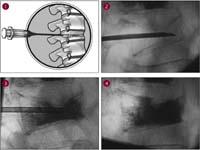2008/02/01
239. zenbakia

eu es fr en cat gl
Aparecerá un contenido traducido automáticamente. ¿Deseas continuar?
Un contenu traduit automatiquement apparaîtra. Voulez-vous continuer?
An automatically translated content item will be displayed. Do you want to continue?
Apareixerà un contingut traduït automàticament. Vols continuar?
Aparecerá un contido traducido automaticamente. ¿Desexas continuar?
New cements to cure vertebral lesions
Text created by automatic translator Elia and has not been subsequently revised by translators.
Elia Elhuyar
Acrylic bone cements based on methylpolymethacrylate (PMMA) have often been used in hip implants for the correct insertion of the prosthesis itself into the bone. In more recent techniques, cement --vertebroplasty, for example- is integrated into the injured vertebra with long and narrow needles, observing the entire process with x-rays.
New cements to cure vertebral lesions
01/02/2008 | Kortabitarte Egiguren, Irati | Elhuyar Zientzia Komunikazioa

(Photo: www.bodyactiveclinics.com)
Vertebroplasty is mainly used to treat vertebral fractures from osteoporosis or bone tumors. The goal is to strengthen the bone and relieve pain. The small wound technique is fast (~40 min/vertebra) and effective to relieve pain (relieves pain between 80% and 90% in 72 hours) thanks to the mechanical reinforcement offered by cement. However, we must take into account the risk of migration of cement and bone necrosis that could occur due to the toxicity of heat and monomer arising from the polymerization reaction. All this is investigated by researchers from the Department of Polymer Science and Technology of the UPV.
Viscosity and radiofrequency
The basic formulation of the cements used in bertebroplasty is monomer, PMMA grains and radiopaque agent. The latter allows to observe the mass of the cement during the injection. All these formulations must generally meet two requirements: adequate viscosity and high radiofrequency. The cement must be strong enough to avoid drips and in turn sufficient fluidity to be injected. It should also be visible with x-rays so that the surgeon can see at all times what is being inserted or injected.
To adapt the formulations currently used to new applications, surgeons often transform cements during surgery, always in order to facilitate injection. To do this, on the one hand, they add to the cement a greater number of monomers in liquid phase, in order to reduce the viscosity and increase the work time of the surgeon, and on the other, they add more radioopaque agents to improve the visualization of the cement by means of. However, these modifications affect the characteristics and toxicity of cement. In this regard, researchers from the Department of Polymer Science and Technology of the UPV/EHU are working on the development of new formulations of acrylic bone cement, taking into account that these are mainly injectable cements, to which an additional therapeutic effect is added, if possible.
UPV-EHU researchers have seen the possibility of obtaining injectable acrylic cements of optimal rheological properties by selecting the appropriate grain size of PMMA. This is because the larger these grains are, the more they squander the heat generated in the polymerization reaction and, therefore, less exothermia occurs in this reaction. Thus, the fabric is not so heated.

In vertebroplasty, cement is inserted into the injured vertebra to strengthen the bone and relieve pain.
Once the size of the PMMA grains is selected, they add to the cement a series of radioopaque or therapeutic agents that can help cure these vertebral lesions and, of course, measure the effects that the increase of these agents can produce on the characteristics of the cements. On the one hand, bismuth salicylate has been added. That is, they have combined the analgesic effect and bismuth of salicylic acid (bismuth metal is easily visible through x-rays). The results show that bismuth offers adequate radiopaquetization, the therapeutic effect of salicylate and, in general, a less toxic combination and adequate compatibility.
On the other hand, bioactive elements have been added to acrylic cement. These elements aim to achieve the interaction between cement and biological tissue (bone regeneration). In particular, extrontzio hydroxyapatite has been included to combine the adequate radiofrequency of strontium with the immediate fixation of acrylic cement and the long-term fixation of the bioactive component.
Finally, in collaboration with other research centers, several studies of in vitro or in vivo biocompatibility have been carried out. According to the results of the studies carried out to date, the cements formulated by the researchers of the UPV/EHU do not present greater problems than conventional commercial cements.
Project overview
New formulations of copolymers and acrylic compounds are being investigated to find efficient bone cements of multiple uses and low side effects.
Directors
Isabel Goñi and Marilo Gurrutxaga.
Working team
I. Goñi, M. Gurrutxaga, I. Silva, R. Rodríguez, P. Casuso.
Department
Polymer Science and Technology.
Faculty
Faculty of Chemistry.
Financing
Basque Government, Provincial Council and Ministry of Education and Science
Working group website:
http://www.sc.ehu.es/powgep99/dcytp/biomaterials/biopolymers.html

On the left, Pablo Casuso, Isabel Goñi, Itziar Silva, Ruth Rodriguez and Marilo Gurrutxaga.
(Photo: I. Kortabitarte)
Kortabitarte Egiguren, Irati
Services
239
2008
Services
045
Chemistry; Universities
Dissemination of knowledge
Other








